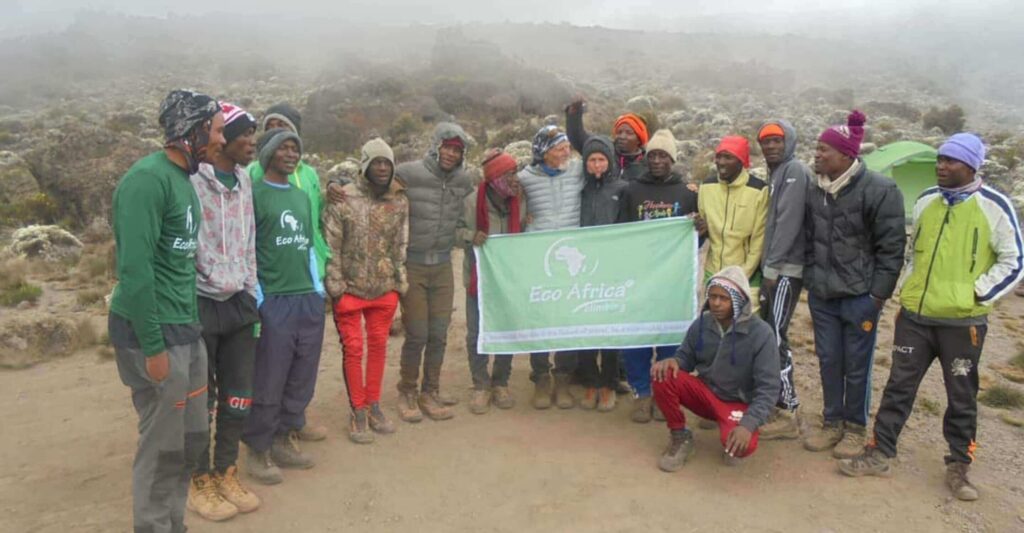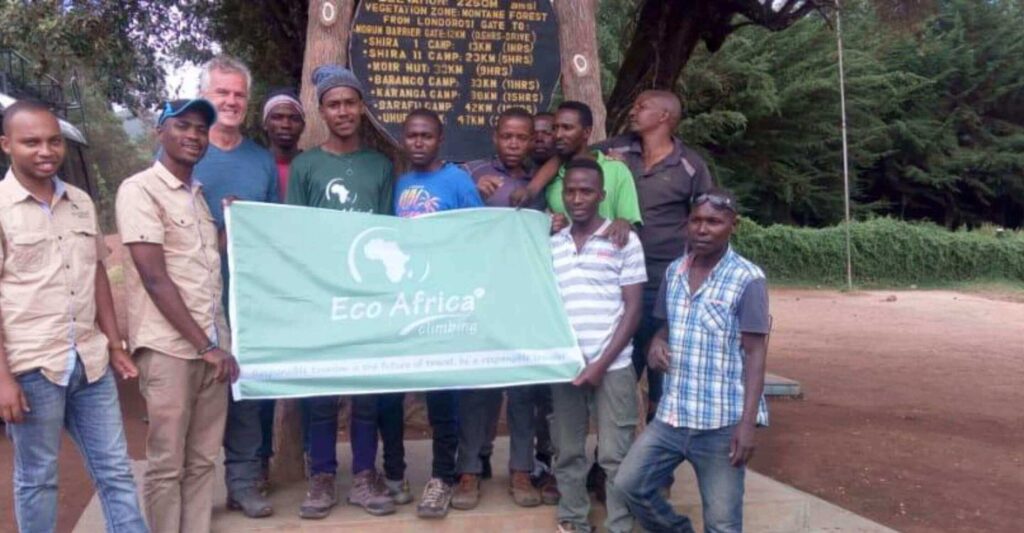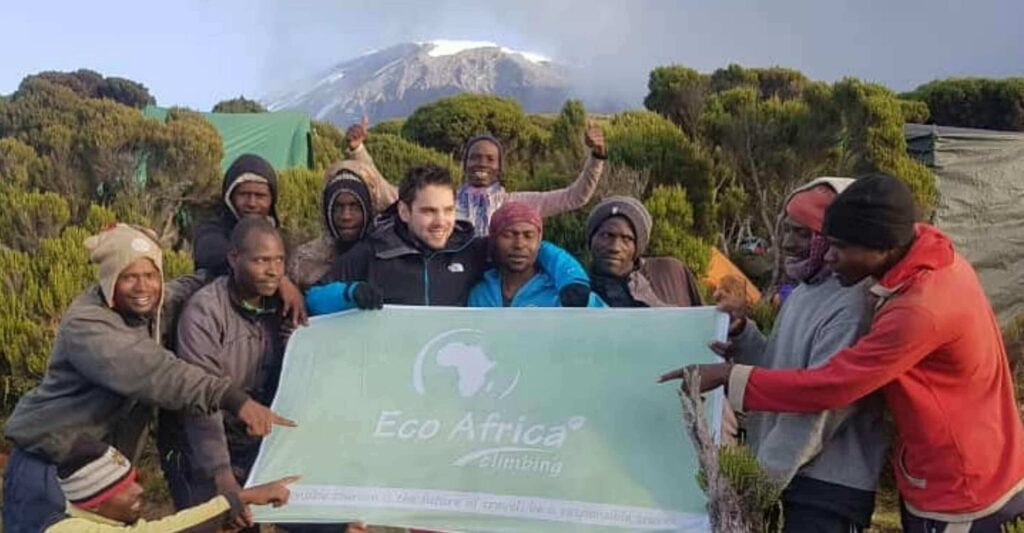WEATHER ON KILIMANJARO MOUNTAIN
The temperatures on Mount Kilimanjaro vary between high and extremely low.
Ascending Kilimanjaro offers a distinctive experience due to various factors, and one of them is the opportunity to traverse multiple distinct climate zones on the way to the top. The route from the base to the summit is akin to a journey from the equator to Antarctica in a matter of days. Mount Kilimanjaro is divided into five main ecological zones, with each zone occupying around 3,280 feet (1,000 m) of altitude. As the elevation increases, each zone undergoes a corresponding reduction in precipitation, temperature, and plant and animal life.
Because of its nearness to the equator, Mount Kilimanjaro encounters limited variations in temperature between different seasons. Instead, the temperatures at various points on the mountain are primarily influenced by the elevation and time of day. The temperature at the base of the mountain, where the climb begins, usually averages between 70 to 80 degrees Fahrenheit (21 to 27 degrees Celsius). However, as you progress through the different ecological zones of the mountain, the temperature will decrease.
At the summit of the mountain, Uhuru Point, the nighttime temperature can range from 20 to -20 degrees Fahrenheit (-7 to -29 degrees Celsius). As a result of Mount Kilimanjaro’s towering height, the mountain generates its own weather, which is highly unpredictable and changeable. Hence, irrespective of the time of year when you climb, it’s essential to be prepared for cold nights and rainy days.
Although the optimal time to climb Kilimanjaro coincides with the “dry” seasons, precipitation and snowfall can happen at any time of the year. As you ascend to higher altitudes, the temperature can fluctuate considerably, with one moment being scorching hot while the next necessitates bundling up against a biting breeze.
Mount Kilimanjaro towers at 19,341 ft above sea level, and it is sizeable enough to generate its own atmospheric conditions. Since it is located on the equator, the mountain obstructs the trade winds (also known as “monsoons”) that cross the ocean and attract moisture upward. This results in the wind rising towards the summit, getting cooler as it climbs and bringing rain and snow with it.
Does Mount Kilimanjaro have snow at its peak?
The trade winds from the southeast are responsible for the extended rainy season between March and May. These winds from the Indian Ocean in the south carry an abundance of moisture, resulting in rainfall on the lower reaches of the mountain and snow at the peak of Mount Kilimanjaro. The southern slopes get the maximum amount of rainfall during this time.
The “short rains” in November are due to a drier wind that originates from the northeast. As it has not traveled across an ocean, the rains during this period are less intense and shorter than the long rainy season. Most of the precipitation during this season falls on the slopes that are farther north.
The five distinct ecological zones of Mount Kilimanjaro.
Listed below are the zones of Mount Kilimanjaro, arranged according to altitude from the lowest to the highest point, along with their average yearly precipitation and distinct characteristics.
Bushland/Cultivated Zone
Elevation: 2,600 to 6,000 ft (800 to 1,800 m)
Amount of rainfall: 20 to 70 inches (500 to 1,800 mm)
The bushland zone, which is situated more than half a mile above sea level, is the lowest altitude climate zone on Mount Kilimanjaro. This zone is characterized by cultivated land, grasslands, and human settlements, with the town of Moshi located in this zone.
The region was once covered by natural bush, lowland forests, and plains. However, the fertile volcanic soil in this area makes it an ideal location for agriculture. The Chagga people migrated to these lower slopes to cultivate a variety of crops, including coffee and tropical fruits that are highly sought after. The irrigation of the land is facilitated by underground channels that pass through the earth from the lush rainforest located above.
Most of the local mountain guides come from the neighboring villages. Large wild animals are a rare sight in this zone, as they were eliminated by farmers many generations ago. Nonetheless, small nocturnal mammals such as galagos and tree hyrax are thriving. A wide variety of birds, such as speckled mouse birds and tropical boubou, can also be found in abundance.
Rain Forest Zone
Elevation: 6,000 to 9,200 ft (1,800 to 2,800 m)
Amount of rainfall: 40 to 79 inches (1,000 to 2,000 mm)
The rainforest zone receives a significant amount of rainfall, approximately six to seven feet annually, and is home to a diverse range of living organisms. The climate is characterized by warm temperatures and high humidity during the day, but the nights can be chilly due to heavy rainfall. It is advisable for climbers to carry rain gear to protect themselves from the constant drizzle.
This zone provides ample opportunities to witness unique African flora and fauna. There are various species of plants, such as orchids, ferns, sycamore figs, olive trees, and palms covered in hanging mosses. Camphorwood trees grow up to 130 feet tall, reaching for sunlight through the dense canopy. A variety of birdlife contributes to a vibrant soundscape, while blue and Colobus monkeys frolic through the trees, loudly calling for mates.
If climbers approach the summit from the Rongai, Lemosho, Shira or Northern Circuit routes, they may even spot larger animals such as elephants, buffaloes, antelopes, and occasional predators on the prowl for prey.
Heath/Moorland Zone
Elevation: 9,200 to 13,200 ft (2,800 to 4,000 m)
Amount of rainfall: 51 to 21 in (1,300 to 530 mm)
The heath zone, also referred to as moorland, is a semi-alpine area featuring heath-like vegetation and plentiful wildflowers. This region is considered part of the “high altitude” zone by mountain medicine, where climbers may experience the initial symptoms of acute mountain sickness. It is typical for most routes to enter this zone on the second day of hiking, and climbers may spend several days here to gradually acclimatize to the decreasing oxygen and higher elevations.
As we ascend higher, the climate becomes drier and cooler, and the dense forest gives way to smaller shrubs like heather, with fewer fauna present. The most distinctive flora in this zone are the endemic Senecios (also known as groundsels) and Giant Lobelias, which are unique to Kilimanjaro Senecios, which get their name from their weathered, thick stems topped with large, succulent rosettes, are particularly noteworthy. Lobelias resemble palm trees with rosettes that close at night to protect against the cold temperatures.
The most commonly seen birds in the heath zone are black and white crows that scavenge for food around the camp. Occasionally, large birds of prey like the crowned eagle and lammergeyer can be observed soaring overhead.
Alpine Desert Zone
Elevation: 13,200 to 16,500 ft (4,000 to 5,000 m)
Amount of rainfall: 10 in (250 mm)
The alpine desert has limited water and as a result, has minimal plant life. In the daytime, temperatures can soar to over 100 degrees Fahrenheit due to the thin air and high levels of solar radiation caused by the zone’s proximity to the equator. Wearing sunscreen is crucial to prevent sunburn. At night, temperatures can drop well below freezing, resulting in frost on tents in the morning.
This region falls under the “very high altitude” category in mountain medicine, and spending ample time here is essential for proper acclimatization for climbers. Our preferred routes will take us through this area a few times before camping at a high altitude on the night before the summit. We advise clients to follow the “climb high, sleep low” principle to minimize the negative effects of altitude sickness.
This dry zone has a sparse amount of soil that cannot retain much water, which makes it unsuitable for most plant and animal species. However, certain plants such as everlastings, tussock grasses, and various types of moss can thrive in such harsh conditions. Only a few animals from the moorland venture up to these elevations, and they are infrequent visitors.
Arctic Zone
Elevation: 16,500+ ft (5,000+ m)
Amount of rainfall: <4 in (100 mm)
The arctic zone is the final region of the climb up Kilimanjaro. It is uncommon to find a region like this in Africa’s equatorial belt, as it is similar to discovering a patch of rainforest in the heart of an Arctic glacier. This area is dominated by ice and rocks, and there is minimal plant or animal life at this altitude. The slopes are covered with glacial silt that was once hidden by receding glaciers that can be seen from the crater rim. The nights in this zone are extremely cold and windy, while the daytime sun is harsh.
Mountain medicine classifies this zone as “extreme altitude” due to the oxygen levels, which are around half of what they are at sea level, causing breathing to become slow and labored. Climbers will pass through this zone on the way to the summit, usually in the middle of the night, so it is essential to wear multiple layers of clothing to stay warm. Expect to endure freezing temperatures and strong winds for 6-8 hours.
Except for crater camp routes, it is uncommon to sleep in this zone as climbers may experience varying degrees of altitude sickness at these elevations. Therefore, it is best to avoid spending too much time here. Climbers summit and descend rapidly before altitude-related symptoms escalate.
To successfully climb Mount Kilimanjaro, you need to be equipped for a diverse range of weather patterns, ranging from warm and humid to cold and blustery. You should also be ready for intense sunlight, rain, and potentially a rare snowstorm.
Typically, the higher you climb, the colder and drier the environment becomes. The majority of your time will be spent in the heath zone and alpine desert, with little time in the rainforest and arctic zones.
For the most part, conditions in these zones are relatively comfortable. During the day, many hikers wear one or two layers, such as a base layer and a softshell jacket. At night, while at camp, people wear warmer clothing, such as a down jacket and fleece pants.
If you climb during the dry season, the weather should generally be pleasant, with mild temperatures, dry conditions, and plenty of sunshine. Don’t be intimidated by the weather, as with the proper gear, you can stay warm and dry even in the harshest conditions.
Our Top Recommended Ethical Kilimanjaro Climbs
Ethical Kilimanjaro via Northern Circuit Route 9 Days
The Northern Circuit route is one of the best routes on Kilimanjaro.The route approaches Mount Kilimanjaro from the west….
From USD $3250
Ethical Kilimanjaro via Lemosho Route 8 Days
The Lemosho route is one of the newer routes on the mountain and a superb choice for your climb, It is our preferred route…
From USD $2950
Ethical Kilimanjaro via Machame Route 7 Days
Machame (“Whiskey”) Route is also known as the “Whiskey” route, the Machame route is now the most popular route on the …
From USD $2650


